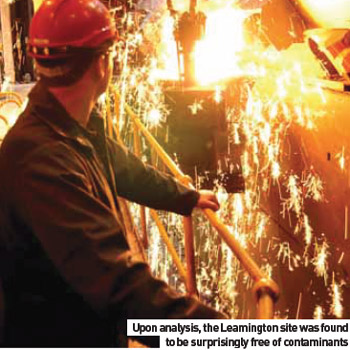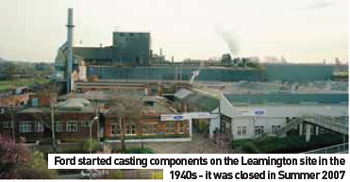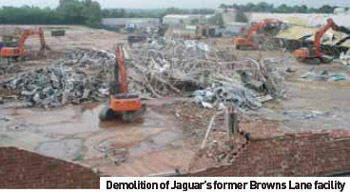Even before the recent slowdown, questions of how to deal with a industrial plant at the end of its useful life had preoccupied automakers for some time. The core concept of what an automotive manufacturing site should be has, after half a century or more of steady evolution, undergone something of a revolution in the last two decades.
Line-side deliveries have meant that original factories are the wrong shape; just-in-time and minimum stock philosophies guarantee they are the wrong size, while market economics often suggest they are also in the wrong place. Whenever an automaker chooses to downsize it’s often the oldest factories that are the first to go and in the current economic climate, that attitude is more prevalent than ever.
But it isn’t simply a case of stripping the equipment and moving on. The vehicles or components that have come off the lines are not the only legacy a redundant facility leaves behind. Industrial processes have environmental consequences, and for the automaker there is an obligation to ensure that, when a site is decommissioned, it does so in a conscientious manner. It isn’t just a case of legislative requirement. In an era of environmentally-responsible car making, there’s little point in the triumph of a producing a vehicle in a technologically advanced, energy-efficient modern plant, if the old plant is still polluting the landscape to the consternation of the local community. It just isn’t good business.
The decommissioning process has become an automotive engineering discipline in its own right, albeit one as much concerned with geophysics, soil chemistry and archaeology as it is with civils and automation. It isn’t necessarily a topic of much discussion – because however well done, shutting down a factory is not something anyone is keen to highlight – but that does not make it any less important.
Ford’s Leamington foundry, located in the English Midlands, began producing cast components on the site in the 1940s, though the foundry itself, in one form or another, had existed since the 1880s. It closed its doors in the summer of 2007, when the production department handed over responsibility to the decommissioning team who were, at the time of writing, finishing the task of preparing the site for new ownership.
 Ford Land Supervisor Derek Saxby is the decommissioning manager for the site. “In the first instance the decommissioning task is concerned with the removal of assets but after that we very seriously ask the question, ‘What are we, as Ford Motor Company, leaving behind?’ Ford takes its responsibilities to the community very seriously, and is rigorous in its decommissioning procedures. We will always carry out a Phase I desktop study, and if that recommends a Phase II intrusive study, that’s what we will do. If the Phase II study suggests a clean-up programme, then that will follow. “ The Phase I desktop (or paper) study is an exercise in collating the history of a location. Experts are commissioned to conduct interviews with current and prior employees and comb local and national archive records to form a complete timeline of the site.
Ford Land Supervisor Derek Saxby is the decommissioning manager for the site. “In the first instance the decommissioning task is concerned with the removal of assets but after that we very seriously ask the question, ‘What are we, as Ford Motor Company, leaving behind?’ Ford takes its responsibilities to the community very seriously, and is rigorous in its decommissioning procedures. We will always carry out a Phase I desktop study, and if that recommends a Phase II intrusive study, that’s what we will do. If the Phase II study suggests a clean-up programme, then that will follow. “ The Phase I desktop (or paper) study is an exercise in collating the history of a location. Experts are commissioned to conduct interviews with current and prior employees and comb local and national archive records to form a complete timeline of the site.
“For Leamington, we employed a specialist company called Arcadis,” says Saxby. “The Phase I report they generated details what they believe to be the history of the site. It covers usage, pollution, environmental concerns etc. When working with the Arcadis team we discovered, for example, that the site was home to a very early example of a petrol station. Called the BP Shell Motor Spirit Station, it may have been the first in England. That piece of information drove further research to pinpoint the location of it.”
The Phase II survey is a more hands-on affair, requiring the digging of bore holes, trenches and test pits. In addition to verifying the physical location of underground workings, it also has a chemical analysis aspect, taking soil and water samples and testing them for a range of contaminants.
“The initial Phase I survey provides the rationale for how many boreholes, probes and trial pits are to be dug,” confirms Saxby. “Bearing in mind the site has been a foundry since the 1880s, it was surprisingly clean. The only real concern was the petrol station we discovered; inevitably environmental damage wasn’t really on the agenda in the 1930s and we uncovered hydrocarbon seepage into the ground, penetrating to a depth of between two and three metres.”
The presence of contaminants does not necessarily lead to a clean-up operation and, in the case of Leamington, the levels of pollution and the intention that the site will continue to be zoned for industrial use meant that, with the relevant information available to potential purchasers, the decommissioning team’s task came to an end after a year and a half on site. It was, acknowledges Saxby, a relatively smooth decommissioning process, which isn’t always the case.
“If you look at early automotive facilities, from the 1920s and 1930s, there wasn’t much notice taken of the environment,” he explains. “The Ford manufacturing plant at Dagenham, which I decommissioned several years ago, is a good example. From a danger point of view, asbestos will almost always be number one on my list of potential hazmats. Following that, the next item of concern is underground storage tanks for oil, petrol and solvents.
Today these would typically be built above ground, but the in the past, the engineering norm when wanting to store those chemicals in large quantities was to dig a hole in the ground, installed a metal tank and covered it over. No-one appreciated that after a period of time the tank would rot from the outside and that these products would absorb water and release it during storage, leading to corrosion from the inside too.
“Beyond that, we pay close attention to underground drainage. Large manufacturing buildings of that era would probably be covered by 11-inch reinforced concrete floor slabs, with a drainage system underneath. Understanding where the drainage system runs is crucial, because the job of removing assets from the site is liable to damage the network before it’s task is completed – and a damaged drainage system obviously poses problems for local water courses. Beyond that there are a variety of other issues to deal with, such as the risk of legionella in wet cooling and the possibility of poorly-documented power and gas supplies running around a site: all of these things mean we don’t begin work dismantling a site before we have a proper understanding of it. The reports are vitally important. We did a solid six months work before Leamington shut down, learning everything we could about the site, but even then, with something the age of Leamington or Dagenham, we might only discover 75 to 80% of the total from the initial survey. The rest we have to discover on site. This is why the process is a very deliberate one.”
While Ford’s Leamington site is soon to have new owners, a few miles up the road in the Coventry, the former Jaguar assembly plant at Browns Lane has already been acquired by developers. Most recently Browns Lane was Jaguar’s headquarters and the assembly facility for the XJ and XK models. When Jaguar moved into higher-volume production with the S-Type and X-Type at other factories, the role of Browns Lane diminished. Eventually Jaguar announced the closure of the main plant, retaining several of its craft operations on the periphery but selling the vast acreage to the international property developer Goodman. Today the buildings have been razed, as Goodman prepares to redevelop the site for a mixture of light and general industrial and residential use. “The site will remain mostly a manufacturing area, with the large factory replaced by lots of smaller units, because that’s where the demand is, but we’re also proposing to build residential developments in two areas of the site, so the character of Browns Lane is definitely changing,” says Paul Heslop, Project Manager for Goodman.
 As was the case with Ford in Leamington, Jaguar commissioned a range of surveys. Goodman participated in the process with Jaguar and, while the carmaker decommissioned certain items of infrastructure before vacating, Goodman essentially inherited the site as it was at the end of production.
As was the case with Ford in Leamington, Jaguar commissioned a range of surveys. Goodman participated in the process with Jaguar and, while the carmaker decommissioned certain items of infrastructure before vacating, Goodman essentially inherited the site as it was at the end of production.
“We bought Browns Lane in its ‘natural’ state, with full cooperation from Jaguar as to what we were likely to find,” says Heslop. “We’ve investigated further to firmly delineate the exact boundaries of contamination ‘hotspots’, so that we can process them when we begin redevelopment.
In essence, firmly defining the line between clean and contaminated soil is part of the process that will allow contractors, when they come on site, to know what they are dealing with. They will have an agreed remediation strategy with the UK Environment Agency (UKEA), detailing targets for the removal of soil contaminants and contaminants in the groundwater. The contractor will carry out his job, we’ll have the soil and water extensively tested again before a final validation document is produced. Arguably, this is the most important report of all, as it confirms that we’ve fulfilled our obligation and the ground is suitably clean. That report is signed-off by the UKEA and the local environmental health officer and will be relied upon by future purchasers.”
The ‘hotspots’ to which Heslop refers are the areas of contamination which trigger a clean-up operation. Were Browns Lane heavily contaminated, clean-up processes would be set up on-site, complete with soil washing facilities.
However, being an assembly plant rather than a heavy process facility, contamination at the Jaguar site is limited to a few areas of hydrocarbon seepage (another petrol station) and some heavy metals. The cheaper and easier solution is to dig out the affected areas and transport the contaminated soil to a disposal facility off-site.
Because Browns Lane will have both industrial and residential zoning, the trigger levels vary according to location. “The environmental guidelines are stringent, and clearly define what is and isn’t acceptable, but they change according to intended end-use,” says Heslop. “For example, slightly elevated levels of a contaminant could be acceptable when that area is going to be buried below an industrial unit or a car park. The trigger level would be different for a residential areas. The concern, obviously, is that people living on the land will want to enjoy their gardens, maybe plant vegetables, and we have to ensure they can do that entirely safely. To define what should and shouldn’t be done, we liaise with the authorities and agree an environmental remediation strategy. The criteria are tougher for land intended for residential use – which doesn’t mean they are lax elsewhere – but if land is going to be under the foundations of an industrial unit, and the contaminants in it are low level and will break down naturally over time, then the outlay required to clean it, might be disproportionate, and it’s this that the UKEA takes into account when deciding what should be done.”
Once the Browns Lane soil has passed it’s final inspection, Goodman’s responsibility for it comes to an end, but the same is not necessarily true of water. Groundwater from the site will continue to be monitored over time for contaminants such as chlorinated solvents which would, if present, impact the local water courses. Groundwater at Browns Lane will likely undergo treatment, either being pumped out, treated and returned to the ground, or treated in situ with chemicals designed to help contaminants break down and naturally dissipate. The final part of this activity is a process known as monitored natural attenuation.
 Basically a timescale is placed on the expected breakdown of pollutants, with the water regularly monitored to ensure it is progressing as planned.
Basically a timescale is placed on the expected breakdown of pollutants, with the water regularly monitored to ensure it is progressing as planned.
“Monitored natural attenuation is agreed when all parties are firmly convinced the results are going to be positive, but that doesn’t make it an easy option,” says Heslop. “Is usually comes as part of a robust remediation package, designed to ensure no contaminants likely to leach into the groundwater remain in the soil. The existing groundwater will most likely also require pre-treatment to help existing contaminants break down and dissipate.”
Preparing redundant automotive brownfield sites for redevelopment can present its own challenges, making the option to develop on greenfield sites seem preferable.
However, because greenfield sites are limited and can have environmental or sustainable-related restrictions, once remediated, brownfield sites have their own benefits and potential. Aside from the obvious environmental compensations of reuse, there are the advantages of building where a transport infrastructure already exists and where service utilities are already on site. Beyond this there is a human factor to take into consideration, as Paul Heslop says in summation: ” This site employed thousands of people, and when the site is redeveloped, there will be job opportunities for thousands of people once more. We’re in an area where people will want those jobs and have the skills to do them, which might not be the case on a greenfield. New industry will thrive here.”
In the current climate, the issue of plant closures is perhaps even more pertinent in North America than it is in Europe. Traditionally, the greater availability of land in the US and Canada has made brownfield re-use less attractive than in overcrowded, land-poor Western Europe. There is, however, a similarly active and vocal environmental movement, and so perhaps it is unsurprising that US legislation and protocol governing plant decommissioning and brownfield reuse mirrors that seen in Europe. Tisha Petteway, spokeswomen for the United States Environmental Protection Agency (EPA), speaks to AMS.
When a factory closes, what responsibilities, if any, does the manufacturer have to rehabilitate the land?
Under the federal Superfund Law (the Comprehensive Environmental Response, Compensation and Liability Act, or CERCLA), owners of contaminated property are liable for the cleanup of their environmental contamination. EPA has the authority to clean up such sites and to compel responsible parties to perform cleanups or reimburse the government for EPA-led cleanups. In addition, some manufacturers may be regulated under the Resource Conservation and Recovery Act (RCRA) due to the fact that the owner or operator of the factor stored, treated, disposed or recycled hazardous wastes on the property. In this case, the owner is required to cleanup contamination and close all regulated units in accordance with the facility’s permit requirements.
In addition to the federal standards governing the cleanup of contaminated properties, state programs may regulate certain aspects of these facilities and cleanup levels.
Does that responsibility change according to the intended future use of the site: i.e. are there stricter rules for land re-zoned for residential use than there would be for site continuing as an industrial area?
All sites are required to meet protective cleanup levels. The level of cleanup may vary depending on the contaminants, exposure, intended land use, and state and local standards. Risk-based cleanups may be used in conjunction with land use controls such as deed restrictions. Is there a standard procedure for tackling clean-up?
Generally, prior to initiating a cleanup, a property owner will undertake a Phase I Environmental Assessment to ascertain what types of wastes, chemicals, and hazardous substances were managed at the property, what types of facilities were located at the property, and what types of waste management activities occurred at the property. During this initial phase of study, an environmental professional will also do an on-site visual assessment of property conditions.
Following the Phase I assessment, if needed, property owners conduct a Phase II assessment that can include sampling and analysis to determine the possible presence and concentration of hazardous constituents in the soils and ground water on the property. Following these site characterisations and sampling activities, the property owner will work with regulatory offi cials at the state or federal level in determining the proper remedy for any contamination at theproperty that exists above regulatory threshold limits. After a remedy is implemented, where needed, land use controls may be placed and post cleanup monitoring plans established.
Is every site different, or are there typical problems involved in the clean-up of an industrial site?
Generally, sites contaminated with similar wastes or hazardous constituents often require similar cleanup activities. Other sites may result in greater challenges due to the variety or type of hazardous constituents present. The age of the property could correlate with the total amount of contamination (e.g., leaking containers, tanks, or landfills may have released contaminants over a longer timeframe), or correlate with the variety of hazardous constituents found at a property (i.e., a greater number and variety or owners or types of businesses located on the property). On the other hand, a property owned for a long period of time by a conscientious owner may result in the fewest environmental problems.
Is reuse of a brownfield considered a more difficult proposal than building on a greenfield? Are there any advantages to taking over a brownfield location?
Brownfield revitalization is complicated by additional costs and uncertainty from the potential contamination. Financial and technical assistance is available to assist brownfields projects including grants, loans, and tax incentives. There are great advantages to cleaning up and building on a brownfield. Most importantly, brownfields often take advantage of existing infrastructure, are near modes of public transportation and reduce development pressure on working lands and greenspaces.
Once a site is redeveloped is that the end of the process or is continuing monitoring of soil and groundwater required for any length of time?
Often, in the case of ground water contamination, additional treatment and monitoring activities may proceed after a property is redeveloped.
Also, if a risked-base remedy is implemented at the site that allows for less stringent clean up, or cleanup to levels below those established for residential property, there most likely will be a land use restriction or institutional control in place at the property to ensure against longterm exposure to hazardous constituents. In these cases, long-term monitoring of any controls placed on the property may be necessary.


































